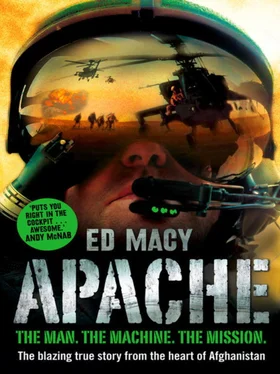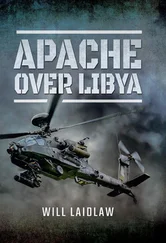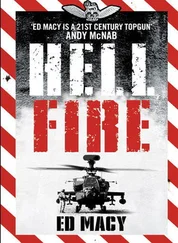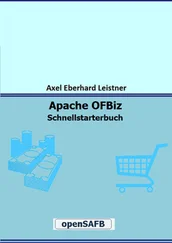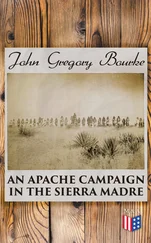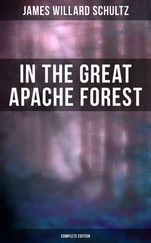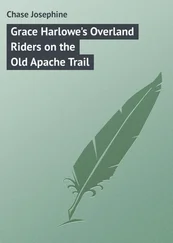On paper, the British Apache was the most expensive – and best – attack helicopter in aviation history. For once, even the Americans were jealous. All the army needed to do now was find the pilots to fly their new creation. And that was the most challenging part of all.
As the most technically advanced helicopter in the world, the Apache AH Mk1 was also the hardest to fly. Selection for the eighteen-month conversion course was even more competitive than Special Forces Selection. Of the Army Air Corps’ 800 pilots, only twenty-four could make it into the Corps’ elite, the six serving Apache squadrons, every year – the top 3 per cent of all British Army pilots. There was no shortage of candidates; the instructors would have passed twice as many if they could have. But the bar couldn’t be lowered, or pilots would start to hit the deck.
To train each Apache pilot from scratch cost £3 million (each custom-made helmet alone had a price tag of £22,915). It took six months just to learn how to fly the machine, another six to know how to fight in it, and a final six to be passed combat ready. And that was if you were already a fully qualified, combat-trained army helicopter pilot. If you weren’t, you’d have to add four months for ground school and learning to fly fixed wing at RAF Barkston Heath, six months learning to fly helicopters at RAF Shawbury, half a year at the School of Army Aviation learning to fly tactically, and a final sixteen-week course in Survival, Evasion and Resistance to Interrogation, courtesy of the Intelligence Corps’ most vigorous training staff. Three years in total.
‘I bet it’s not as tough as you and the Yanks make out,’ I said to Billy on Day One. He smiled.
It was the hardest thing I have ever done, or will ever do. Some of the best pilots I’ve known fell by the wayside during Apache conversion training. Cranchy was an instructor for twelve years. He failed. Paul was the chief instructor for an entire regiment, and he failed. Mac was a display pilot with the Blue Eagles and got an MBE for it. He failed too.
Why was the aircraft so hard to master? In a nutshell: because of the unimaginably demanding need to multi-task. Taking an Apache into battle was like playing an Xbox, a PlayStation and a chess Grand Master simultaneously – whilst riding Disneyworld’s biggest roller coaster. US studies found that only a very small percentage of human brains could do everything required simultaneously to operate the aircraft.
Information overload was a major issue. At least ten different new facts had to be registered, processed and acted on every few seconds in the cockpit. We were constantly bombarded with new information – from the flight instruments, four different radio frequencies chattering at the same time, the internal intercom, the weapons computers’ targeting, the defensive aid suite’s threats and the Longbow Radar.
Then there were the challenges outside the cockpit too. We had to know the position of our wingmen, the whereabouts of other allied jets and helicopters, spot for small arms fire flashes on the ground, remember friendly ground forces’ positions and keep a visual lookout for the target.
All this not just for a minute or two, but for three hours without a break. Miss one vital element, and you would kill yourself and your co-pilot in an instant.
US pilots called flying an Apache ‘Riding the dragon’. If you got something wrong or irritated the machine, it turned around and bit you. A cool temperament was even more important than a good pair of eyes and ears – the ability not to panic no matter what was being demanded of you.
The second great challenge was physical coordination. Flying an Apache almost always meant both hands and feet doing four different things at once. Even our eyes had to learn how to work independently of each other.
A monocle sat permanently over our right iris. A dozen different instrument readings from around the cockpit were projected into it. At the flick of a button, a range of other images could also be superimposed underneath the green glow of the instrument symbology, replicating the TADS’ or PNVS’ camera images and the Longbow Radars’ targets.
The monocle left the pilot’s left eye free to look outside the cockpit, saving him the few seconds that it took to look down at the instruments then up again; seconds that could mean the difference between our death and our enemy’s.
New pilots suffered terrible headaches as the left and right eye competed for dominance. They started within minutes, long before take-off. If you admitted to them, the instructor grounded you immediately – so none of us ever did. Instead, you had to ‘man up’ and get on with it.
As the eyes adjusted over the following weeks and months the headaches took longer to set in. It was a year before mine disappeared altogether. A few weeks out of the cockpit though, and they’d be back again on a high concentration sortie – low level, large formation, poor weather, under pylons, hunting and being hunted by the enemy.
It took me two years to learn how to ‘see’ properly – how to see in Apache World. I once filmed my face during a sortie with a video camera as an experiment. My eyes whirled independently of each other throughout, like a man possessed.
‘That’s disgusting,’ Emily said when I showed her the tape. ‘But does it mean you can read two books at once?’
I tried it. I could.
Being a member of the world’s most exclusive aviators’ club had its personal price. It was also very tough on Emily, the other wives and girlfriends and especially our children. When we started, our American counterparts warned us about AIDS – Apache Induced Divorce Syndrome. Marriage and the Apache didn’t sit well together.
To master the machine, we had to eat, sleep and breathe it. It was an obsession, and it had to be. There was never time to stop and relax in the cockpit, the simulator or the classroom. If there was, you were forgetting to do something. ‘You can sleep when you’re dead,’ the instructors loved to say.
It was the same on the squadron once we’d all qualified. Apache pilots were at work for fourteen hours a day, every day, just to keep on track. You had to stay one step ahead of the aircraft at all times. If you didn’t, it would turn and bite you.
Unlike any other army units, there were very few ‘sirs’ used among the aircrew in our squadron. Officers called each other by their first names, and the other ranks did the same with each other. We’d gone through so much together, proved ourselves so many times, the ceremony of official title felt redundant. We were all close friends – and it felt odd to call a good mate ‘sir’. Above all, we didn’t have the time.
There was one more quality you needed to be an Apache pilot. The best attack pilots had the soul of an infantryman. Army Air Corps personnel had always been known as flying soldiers rather than pilots. It’s why we preferred to wear combat fatigues and not flying suits – with the exception of Billy, of course. The founding ethos of the Corps, since the first time soldiers took to the air to artillery spot from their nineteenth-century balloons, was to help the blokes on the ground win the fight – and that wouldn’t ever change.
‘We’re going through the wood,’ the ground commander might have said to us as we provided top cover in a Gazelle or a Lynx.
‘Roger,’ we’d reply. ‘Move slowly and we’ll cover the treeline and the high ground.’
You could teach a monkey how to fly; Soviet scientists proved that during the Cold War by attaching electrodes to a cyclic stick. But you couldn’t teach a monkey how to fix a bayonet and charge. To fight an Apache, it wasn’t enough to be a gifted pilot and a geeky tech-head. That would only get you to where you needed to be at the right time. The real challenge was what happened next.
Читать дальше
Конец ознакомительного отрывка
Купить книгу
